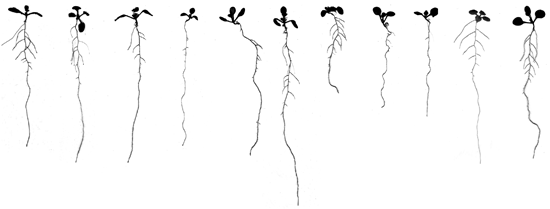
How root system architecture is determined by intrinsic developmental programs is one of our favorite subjects. It is intricately linked to plant hormone signaling, and we like to exploit natural genetic variation as well as targeted mutant approaches to find and characterize regulators of root growth. In the ecological-evolutionary context, we are particularly interested in molecular mechanisms that confer root adaptation to acidic soil. Soil pH is particularly important for plant performance, since it is directly related to nutrient accessibility. Optimal soil pH for plant growth typically ranges from ca. 5.5-6.5, however, most plants manage on a wider range (ca. 5.0-7.5). Yet some plant species have evolved strategies to cope with the different aspects of excess soil acidity (pH < 5.0), notably aluminium ion toxicity, low phosphate availability and proton toxicity. However, the molecular basis for such adaptations is largely unknown, preventing its exploitation for targeted crop adaptation to acidic soil. For sustainable agriculture, this would be important, because in the agro-ecological context, soil acidification (for example as a result of sustained ammonium fertilization or industrial pollutants such as sulphur dioxide emissions) is a major problem that limits crop range and contributes to the effective shrinking of available agricultural surface. Find out more about our resesarch on root system development and its adaptive value in the following publications:
Bojan Gujas, Carlos Alonso-Blanco and Christian S. Hardtke (2012): Natural Arabidopsis brx loss of function alleles confer root adaptation to acidic soil. Current Biology, Vol. 22: pp. 1962-1968.
David Pacheco-Villalobos and Christian S. Hardtke (2012): Natural genetic variation of root system architecture from Arabidopsis to Brachypodium: towards adaptive value. Philosophical Transactions of the Royal Society B, Vol. 367: pp. 1552-1558.
Christian S. Hardtke and Kaisa Nieminen (2011): Advances in identifying and exploiting natural genetic variation. Plant biotechnology and agriculture: Prospects for the 21st century, pp. 195-205.
Julien Beuchat, Shuwei Li, Laura Ragni, Chikako Shindo, Michael H. Kohn and Christian S. Hardtke (2010): A hyperactive QTL allele of Arabidopsis BRX contributes to natural variation in root growth vigor. Proceedings of the National Academy of Sciences U.S.A., Vol. 107: pp. 8475-8480.
Americo Rodrigues, Julia Santiago, Silvia Rubio, Angela Saez, Karen S. Osmont, Jose Gadea, Christian S. Hardtke and Pedro L. Rodriguez (2009): The short-rooted phenotype of the brevis radix mutant partly reflects root ABA hypersensitivity. Plant Physiology, Vol. 149: pp. 1917-28.
Chikako Shindo, Giorgina Bernasconi and Christian S. Hardtke (2008): Intra-specific competition reveals conditional fitness effects of single gene polymorphism at the Arabidopsis root growth regulator BRX. New Phytologist, Vol. 180: pp. 71-80.
Karen S. Osmont, Richard Sibout and Christian S. Hardtke (2007): Hidden Branches: Developments in Root System Architecture. Annual Review of Plant Biology, Vol. 58: pp. 93-113.
Chikako Shindo, Giorgina Bernasconi and Christian S. Hardtke (2007): Natural genetic variation in Arabidopsis: tools, traits and prospects for Evolutionary Ecology. Annals of Botany, Vol. 99: pp. 1043-1054.
Céline F. Mouchel, Karen S. Osmont and Christian S. Hardtke (2006): BRX mediates feedback between brassinosteroid levels and auxin signalling in root growth. Nature, Vol. 443: pp. 458-461.
Christian S. Hardtke (2006): Root development – branching into novel spheres. Current Opinions in Plant Biology, Vol. 9: pp. 66-71.
Céline F. Mouchel, Georgette C. Briggs and Christian S. Hardtke (2004): Natural genetic variation in Arabidopsis identifies BREVIS RADIX, a novel regulator of cell proliferation and elongation in the root. Genes & Development, Vol. 18: pp. 700-714.
